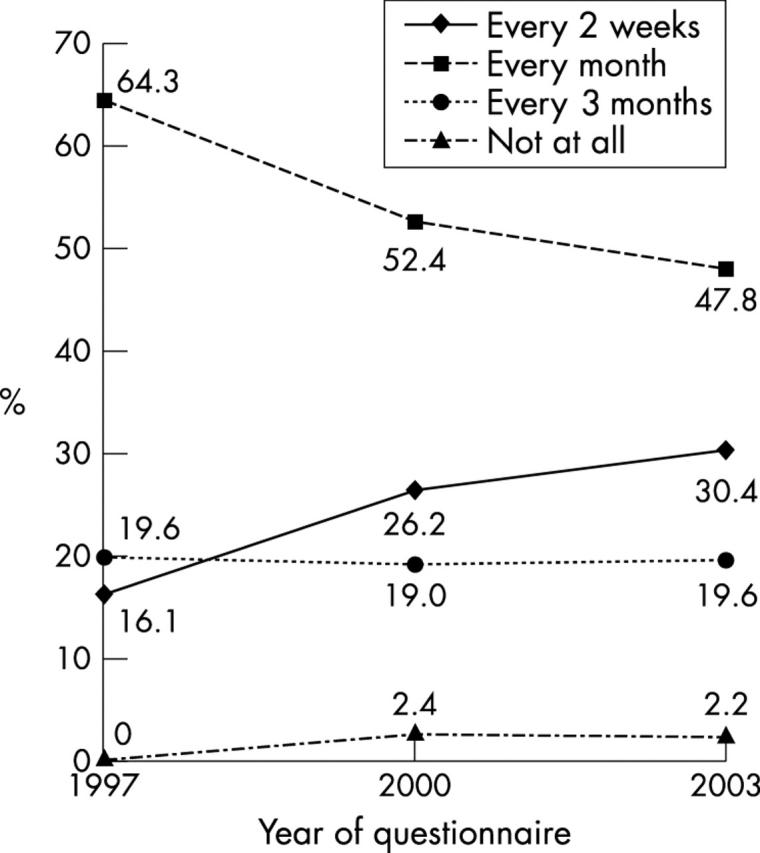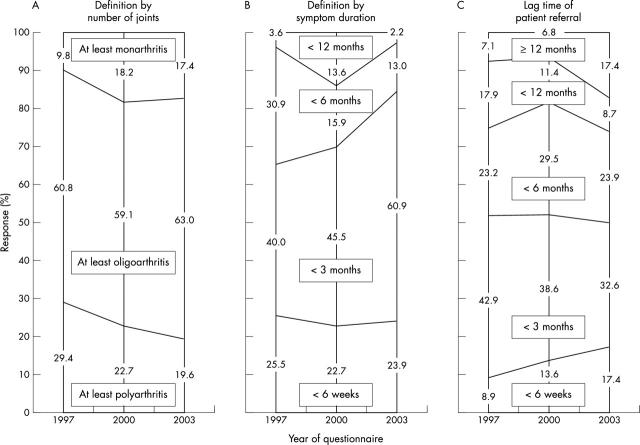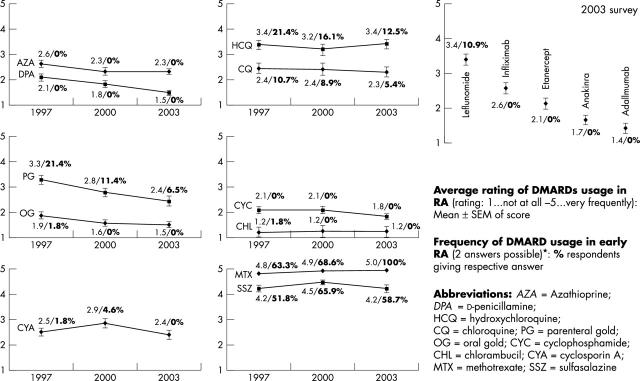Abstract
Objective: To determine if rheumatologists have changed their views on diagnosis and treatment of early rheumatoid arthritis (RA).
Methods: Three consecutive questionnaires were sent out to international rheumatologists in 1997, 2000, and 2003. The following aspects of early RA were covered: definition; patient referral time; diagnostic means; follow up intervals; and treatment strategies. All initial participants who responded to at least one of the follow up surveys were included in the analysis.
Results: RA is now defined by a smaller number of affected joints (monarthritis: 9.8% respondents in 1997 v 17.4% in 2003), and shorter symptom duration (<3 months: 65.5% in 1997 v 85.8% in 2003). Early referrals (<6 weeks) increased (8.9% in 1997 v 17.4% in 2003). Serological test for diagnosis was mostly rheumatoid factor (100% in 2003), but anti-CCP was already used by 17.4% in 2003. Follow up of patients with early RA intensified (every 2 weeks: 16.1% in 1997 v 30.4% in 2003; every month: 47.8% in 2003 v 64.3% in 1997). Treatment with disease modifying antirheumatic drugs (DMARDs) mainly comprised methotrexate, sulfasalazine, and antimalarial drugs. Leflunomide was among the two favourite DMARDs of 10.9% in 2003, whereas no biological agent was so. In 2003, 46.7% respondents started treatment with DMARDs if RA was suspected (30.9% in 1997); no one waited for erosions to occur (7.3% in 1997).
Conclusion: The data obtained in this study suggest that the concept of diagnosing and treating RA early is accepted by a large proportion of the rheumatological community.
Full Text
The Full Text of this article is available as a PDF (278.6 KB).
Figure 1.
Cumulative presentation of opinions individually matched for responders to at least one of the follow up questionnaires between 1997 and 2003. The following questions were asked and allowed just one answer (total number of matched responders: n = 56/44/46 for the years 1997/2000/2003): (A) What extent of arthritis do you at least require for a definition of early RA? (valid answers: n = 51/44/46). (B) What maximum duration of symptoms do you still regard as early RA? (valid answers: n = 55/44/46). (C) How long on average from onset of symptoms does it take until patients with arthritis are referred to you? (valid answers: n = 56/44/46).
Figure 2.

How often do you see your patients with early arthritis during the first 3 months? Individually matched opinions of responders to at least one of the follow up questionnaires between 1997 and 2003 are presented (total number of matched responders: n = 56/44/46 for the years 1997/2000/2003; there were no missing data). Only the choice of one of the four time intervals was possible for each responder.
Figure 3.

When do you start DMARD treatment in patients with newly diagnosed RA? Individually matched opinions of responders to at least one of the follow up questionnaires between 1997 and 2003 are presented (total number of matched responders: n = 56/44/46 for the years 1997/2000/2003; valid answers: n = 55/43/45). Only one choice out of six options (A–E) was possible for each responder. No responder picked the option: NSAID failure >12 months.
Figure 4.
DMARD treatment in patients with established RA and early RA. Established RA: Lines present means (SEM) of valid answers on the frequency of DMARD usage in established RA (left score in legends); the rating scale ranged from "1" (not at all) to "5" (very frequently). Valid answers in 1997 (n = 56), 2000 (n = 44), and 2003 (n = 46) for the individual DMARDs given: 50–55/42–44/46. Early RA: Percentages given on right in legends refer to the proportion of responders who stated that they used the respective DMARD in early RA (two choices were allowed; however, percentages may not exactly add up to 200%, because some responders gave only one answer). Valid responders: 55/44/46.
Selected References
These references are in PubMed. This may not be the complete list of references from this article.
- Aletaha D., Eberl G., Nell V. P. K., Machold K. P., Smolen J. S. Practical progress in realisation of early diagnosis and treatment of patients with suspected rheumatoid arthritis: results from two matched questionnaires within three years. Ann Rheum Dis. 2002 Jul;61(7):630–634. doi: 10.1136/ard.61.7.630. [DOI] [PMC free article] [PubMed] [Google Scholar]
- Anderson J. J., Wells G., Verhoeven A. C., Felson D. T. Factors predicting response to treatment in rheumatoid arthritis: the importance of disease duration. Arthritis Rheum. 2000 Jan;43(1):22–29. doi: 10.1002/1529-0131(200001)43:1<22::AID-ANR4>3.0.CO;2-9. [DOI] [PubMed] [Google Scholar]
- Arnett F. C., Edworthy S. M., Bloch D. A., McShane D. J., Fries J. F., Cooper N. S., Healey L. A., Kaplan S. R., Liang M. H., Luthra H. S. The American Rheumatism Association 1987 revised criteria for the classification of rheumatoid arthritis. Arthritis Rheum. 1988 Mar;31(3):315–324. doi: 10.1002/art.1780310302. [DOI] [PubMed] [Google Scholar]
- Bathon J. M., Martin R. W., Fleischmann R. M., Tesser J. R., Schiff M. H., Keystone E. C., Genovese M. C., Wasko M. C., Moreland L. W., Weaver A. L. A comparison of etanercept and methotrexate in patients with early rheumatoid arthritis. N Engl J Med. 2000 Nov 30;343(22):1586–1593. doi: 10.1056/NEJM200011303432201. [DOI] [PubMed] [Google Scholar]
- Boers M., Verhoeven A. C., Markusse H. M., van de Laar M. A., Westhovens R., van Denderen J. C., van Zeben D., Dijkmans B. A., Peeters A. J., Jacobs P. Randomised comparison of combined step-down prednisolone, methotrexate and sulphasalazine with sulphasalazine alone in early rheumatoid arthritis. Lancet. 1997 Aug 2;350(9074):309–318. doi: 10.1016/S0140-6736(97)01300-7. [DOI] [PubMed] [Google Scholar]
- Boers Maarten. Understanding the window of opportunity concept in early rheumatoid arthritis. Arthritis Rheum. 2003 Jul;48(7):1771–1774. doi: 10.1002/art.11156. [DOI] [PubMed] [Google Scholar]
- Bukhari M. A. S., Wiles N. J., Lunt M., Harrison B. J., Scott D. G. I., Symmons D. P. M., Silman A. J. Influence of disease-modifying therapy on radiographic outcome in inflammatory polyarthritis at five years: results from a large observational inception study. Arthritis Rheum. 2003 Jan;48(1):46–53. doi: 10.1002/art.10727. [DOI] [PubMed] [Google Scholar]
- Egsmose C., Lund B., Borg G., Pettersson H., Berg E., Brodin U., Trang L. Patients with rheumatoid arthritis benefit from early 2nd line therapy: 5 year followup of a prospective double blind placebo controlled study. J Rheumatol. 1995 Dec;22(12):2208–2213. [PubMed] [Google Scholar]
- Emery P., Salmon M. Early rheumatoid arthritis: time to aim for remission? Ann Rheum Dis. 1995 Dec;54(12):944–947. doi: 10.1136/ard.54.12.944. [DOI] [PMC free article] [PubMed] [Google Scholar]
- Fries J. F. Reevaluating the therapeutic approach to rheumatoid arthritis: the "sawtooth" strategy. J Rheumatol Suppl. 1990 May;22:12–15. [PubMed] [Google Scholar]
- Harrison B., Symmons D. Early inflammatory polyarthritis: results from the Norfolk Arthritis Register with a review of the literature. II. Outcome at three years. Rheumatology (Oxford) 2000 Sep;39(9):939–949. doi: 10.1093/rheumatology/39.9.939. [DOI] [PubMed] [Google Scholar]
- Hassfeld W., Steiner G., Graninger W., Witzmann G., Schweitzer H., Smolen J. S. Autoantibody to the nuclear antigen RA33: a marker for early rheumatoid arthritis. Br J Rheumatol. 1993 Mar;32(3):199–203. doi: 10.1093/rheumatology/32.3.199. [DOI] [PubMed] [Google Scholar]
- Janssens X., Veys E. M., Verbruggen G., Declercq L. The diagnostic significance of the antiperinuclear factor for rheumatoid arthritis. J Rheumatol. 1988 Sep;15(9):1346–1350. [PubMed] [Google Scholar]
- Landewé Robert B. M., Boers Maarten, Verhoeven Arco C., Westhovens Rene, van de Laar Mart A. F. J., Markusse Harry M., van Denderen J. Christiaan, Westedt Marie Louise, Peeters Andre J., Dijkmans Ben A. C. COBRA combination therapy in patients with early rheumatoid arthritis: long-term structural benefits of a brief intervention. Arthritis Rheum. 2002 Feb;46(2):347–356. doi: 10.1002/art.10083. [DOI] [PubMed] [Google Scholar]
- Lard L. R., Visser H., Speyer I., vander Horst-Bruinsma I. E., Zwinderman A. H., Breedveld F. C., Hazes J. M. Early versus delayed treatment in patients with recent-onset rheumatoid arthritis: comparison of two cohorts who received different treatment strategies. Am J Med. 2001 Oct 15;111(6):446–451. doi: 10.1016/s0002-9343(01)00872-5. [DOI] [PubMed] [Google Scholar]
- Machold Klaus P., Stamm Tanja A., Eberl Gabriele J. M., Nell Valerie K. P., Dunky Attila, Uffmann Martin, Smolen Josef S. Very recent onset arthritis--clinical, laboratory, and radiological findings during the first year of disease. J Rheumatol. 2002 Nov;29(11):2278–2287. [PubMed] [Google Scholar]
- Möttönen T., Hannonen P., Leirisalo-Repo M., Nissilä M., Kautiainen H., Korpela M., Laasonen L., Julkunen H., Luukkainen R., Vuori K. Comparison of combination therapy with single-drug therapy in early rheumatoid arthritis: a randomised trial. FIN-RACo trial group. Lancet. 1999 May 8;353(9164):1568–1573. doi: 10.1016/s0140-6736(98)08513-4. [DOI] [PubMed] [Google Scholar]
- O'Dell J. R. The therapeutic pyramid: a work in progress. J Rheumatol. 1997 Jun;24(6):1028–1030. [PubMed] [Google Scholar]
- Proudman S. M., Conaghan P. G., Richardson C., Griffiths B., Green M. J., McGonagle D., Wakefield R. J., Reece R. J., Miles S., Adebajo A. Treatment of poor-prognosis early rheumatoid arthritis. A randomized study of treatment with methotrexate, cyclosporin A, and intraarticular corticosteroids compared with sulfasalazine alone. Arthritis Rheum. 2000 Aug;43(8):1809–1819. doi: 10.1002/1529-0131(200008)43:8<1809::AID-ANR17>3.0.CO;2-D. [DOI] [PubMed] [Google Scholar]
- Schellekens G. A., Visser H., de Jong B. A., van den Hoogen F. H., Hazes J. M., Breedveld F. C., van Venrooij W. J. The diagnostic properties of rheumatoid arthritis antibodies recognizing a cyclic citrullinated peptide. Arthritis Rheum. 2000 Jan;43(1):155–163. doi: 10.1002/1529-0131(200001)43:1<155::AID-ANR20>3.0.CO;2-3. [DOI] [PubMed] [Google Scholar]
- Silman A. J., Symmons D. P. Selection of study population in the development of rheumatic disease criteria: comment on the article by the American College of Rheumatology Diagnostic and Therapeutic Criteria Committee. Arthritis Rheum. 1995 May;38(5):722–723. doi: 10.1002/art.1780380527. [DOI] [PubMed] [Google Scholar]
- Simon M., Girbal E., Sebbag M., Gomès-Daudrix V., Vincent C., Salama G., Serre G. The cytokeratin filament-aggregating protein filaggrin is the target of the so-called "antikeratin antibodies," autoantibodies specific for rheumatoid arthritis. J Clin Invest. 1993 Sep;92(3):1387–1393. doi: 10.1172/JCI116713. [DOI] [PMC free article] [PubMed] [Google Scholar]
- Smolen Josef S., Steiner Günter. Therapeutic strategies for rheumatoid arthritis. Nat Rev Drug Discov. 2003 Jun;2(6):473–488. doi: 10.1038/nrd1109. [DOI] [PubMed] [Google Scholar]
- Tsakonas E., Fitzgerald A. A., Fitzcharles M. A., Cividino A., Thorne J. C., M'Seffar A., Joseph L., Bombardier C., Esdaile J. M. Consequences of delayed therapy with second-line agents in rheumatoid arthritis: a 3 year followup on the hydroxychloroquine in early rheumatoid arthritis (HERA) study. J Rheumatol. 2000 Mar;27(3):623–629. [PubMed] [Google Scholar]
- Verstappen Suzan M. M., Jacobs Johannes W. G., Bijlsma Johannes W. J., Heurkens Anton H. M., van Booma-Frankfort Christina, Borg Evert Jan ter, Hofman Dick M., van der Veen Maaike J., Utrecht Arthritis Cohort Study Group Five-year followup of rheumatoid arthritis patients after early treatment with disease-modifying antirheumatic drugs versus treatment according to the pyramid approach in the first year. Arthritis Rheum. 2003 Jul;48(7):1797–1807. doi: 10.1002/art.11170. [DOI] [PubMed] [Google Scholar]
- Vincent C., Serre G., Lapeyre F., Fournié B., Ayrolles C., Fournié A., Soleilhavoup J. P. High diagnostic value in rheumatoid arthritis of antibodies to the stratum corneum of rat oesophagus epithelium, so-called 'antikeratin antibodies'. Ann Rheum Dis. 1989 Sep;48(9):712–722. doi: 10.1136/ard.48.9.712. [DOI] [PMC free article] [PubMed] [Google Scholar]
- Visser Henk, le Cessie Saskia, Vos Koen, Breedveld Ferdinand C., Hazes Johanna M. W. How to diagnose rheumatoid arthritis early: a prediction model for persistent (erosive) arthritis. Arthritis Rheum. 2002 Feb;46(2):357–365. doi: 10.1002/art.10117. [DOI] [PubMed] [Google Scholar]
- Wilske K. R., Healey L. A. Remodeling the pyramid--a concept whose time has come. J Rheumatol. 1989 May;16(5):565–567. [PubMed] [Google Scholar]
- Wolfe F. The natural history of rheumatoid arthritis. J Rheumatol Suppl. 1996 Mar;44:13–22. [PubMed] [Google Scholar]
- Yelin E., Wanke L. A. An assessment of the annual and long-term direct costs of rheumatoid arthritis: the impact of poor function and functional decline. Arthritis Rheum. 1999 Jun;42(6):1209–1218. doi: 10.1002/1529-0131(199906)42:6<1209::AID-ANR18>3.0.CO;2-M. [DOI] [PubMed] [Google Scholar]
- van der Heide A., Jacobs J. W., Bijlsma J. W., Heurkens A. H., van Booma-Frankfort C., van der Veen M. J., Haanen H. C., Hofman D. M., van Albada-Kuipers G. A., ter Borg E. J. The effectiveness of early treatment with "second-line" antirheumatic drugs. A randomized, controlled trial. Ann Intern Med. 1996 Apr 15;124(8):699–707. doi: 10.7326/0003-4819-124-8-199604150-00001. [DOI] [PubMed] [Google Scholar]




